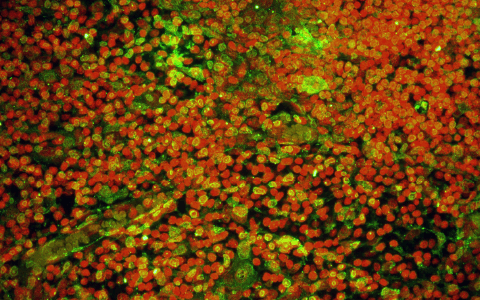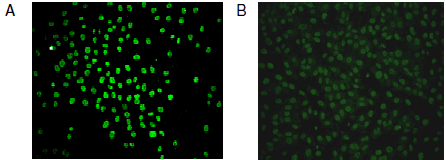8-OHdG (also known as 8-oxo-dG, 8-hydroxydeoxyguanosine) is a product of DNA oxidative damage caused by reactive oxygen species (ROS).  Used as a marker to detect oxidative damage and DNA mutations. When reactive oxygen species such as hydroxyl radicals and superoxide anions attack the 8th carbon atom of the guanine base in the DNA molecule, an oxidative adduct 8-OHdG can be formed, thereby changing the spatial structure of the DNA strand. This mutation is difficult to repair or repair very slowly, often an important event in the process of mutation caused by reactive oxygen species. Therefore, 8-OHdG has been widely used in experiments and clinical studies, and participates in the detection and mechanism analysis of oxidative stress and pathological indicators.
Used as a marker to detect oxidative damage and DNA mutations. When reactive oxygen species such as hydroxyl radicals and superoxide anions attack the 8th carbon atom of the guanine base in the DNA molecule, an oxidative adduct 8-OHdG can be formed, thereby changing the spatial structure of the DNA strand. This mutation is difficult to repair or repair very slowly, often an important event in the process of mutation caused by reactive oxygen species. Therefore, 8-OHdG has been widely used in experiments and clinical studies, and participates in the detection and mechanism analysis of oxidative stress and pathological indicators.
Previous detection of 8-OHdG content can be first determined by high performance liquid chromatography followed by electrochemical detection, but such operation costs are relatively high. With the gradual maturity of immunological techniques, the development and use of 8-OHdG-specific monoclonal antibodies as a tool for 8-OHdG quantification has broad application prospects. Amy Jettor recommends the 8-OHdG/8-oxo-dG antibody from Trevigen, a cell damage assay specialist.
 The Anti-8-oxo-dG Monoclonal Antibody (clone 2E2) antibody is a mouse monoclonal 8-OHdG/8-oxo-dG antibody, and the immunogen prepared by KLH-conjugated 8-oxo-dG Murine mAb was prepared and finally screened for a monoclonal antibody having the clone number 2E2, which is a subtype of IgG2b. It has a very high specificity and can specifically bind 8-hydroxydeoxyguanosine (8-oxo-dG) in DNA. The antibody has also been used in ELISA, immunocytochemical ICC, and immunohistochemistry IHC, and has been widely used in the quantitative and localization studies of 8-oxo-dG.
The Anti-8-oxo-dG Monoclonal Antibody (clone 2E2) antibody is a mouse monoclonal 8-OHdG/8-oxo-dG antibody, and the immunogen prepared by KLH-conjugated 8-oxo-dG Murine mAb was prepared and finally screened for a monoclonal antibody having the clone number 2E2, which is a subtype of IgG2b. It has a very high specificity and can specifically bind 8-hydroxydeoxyguanosine (8-oxo-dG) in DNA. The antibody has also been used in ELISA, immunocytochemical ICC, and immunohistochemistry IHC, and has been widely used in the quantitative and localization studies of 8-oxo-dG.
As the most versatile indicator for the detection and detection of DNA damage, 8-hydroxy-2-deoxyguanosine (8-oxo-dG) antibodies are used to detect oxygen free radicals produced by inflammation, carcinogenicity, senile dementia, and aging. The 8-OHdG/8-oxo-dG monoclonal antibody is available in a 50 ul liquid form (high titer, such as a recommended dilution ratio of 1:250 for ICC experiments), and the antibody solution contains 0.01% sodium azide. As a preservative. We recommend that you store the antibody at -20 degrees or lower, dispense and avoid repeated freezing and thawing. The antibody can be used as an ELISA assay (Trevigen commercial 8-OHdG/8-oxo-dG ELISA assay kit), as well as immunochemical and immunofluorescence assays for cells or tissues.
Amy Jet provides you with a one-stop solution for cell pressure and DNA damage detection. These protocols include DNA double-strand break damage, comet assays, and SOD enzymes. In addition to 8-oxo-dG antibody products, there are quantitative 8-oxo-dG ELISA kits and other related products. If you are interested in the above products and solutions, please contact Amy Jie Technology Co., Ltd. for cell damage and stress. Research related experimental solutions or request the latest product information.
Trevigen is a fast-growing US biotechnology company focused on oncology research products and services for apoptosis, DNA damage and repair, tumor cell function and behavior. As the general agent of Trevigen in China, Amy Jie and Trevigen provide Chinese researchers with the best and latest quality products and technical services in the fields of oxidative stress, cell damage and tumor cell behavior research.
Wuhan Amyjet Scientific Inc.
Address: 7A, Unit 1, Block 111, Mingdu Garden, 450 Xiongchu Avenue, Hongshan District, Wuhan
Website: http:// (Article source)
Stomach Tube,stomach tube sizes,Feeding Tube,tube feeding
Anesthesia Medical Co., Ltd. , https://www.jssinoanesthesia.com